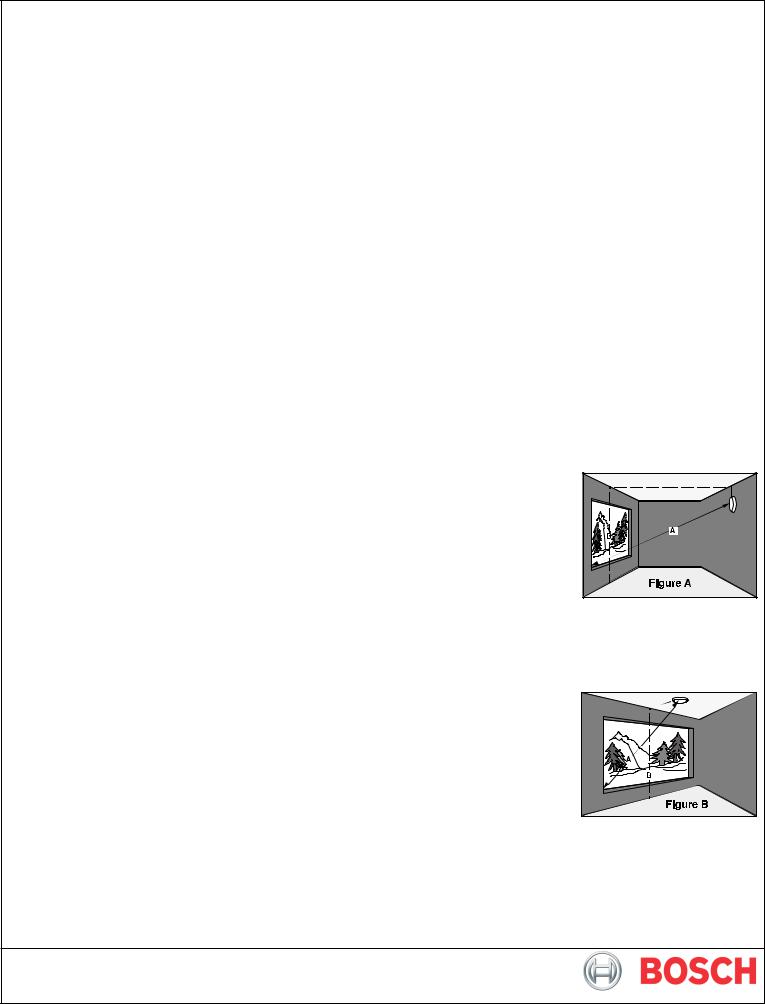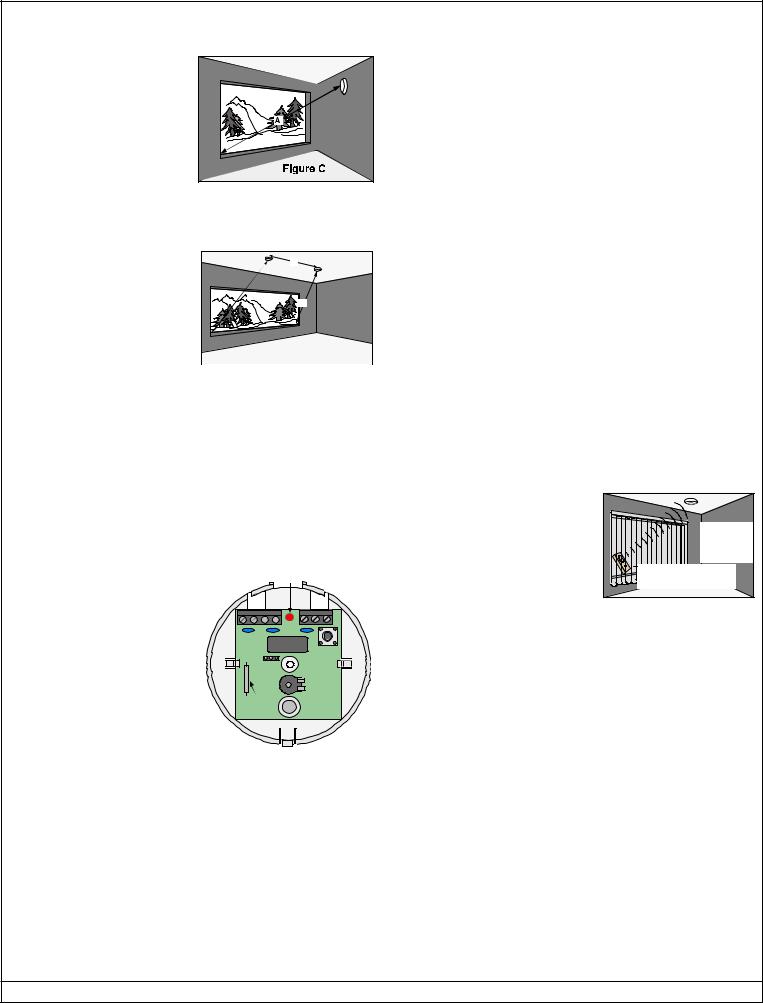Bosch DS1101I, DS1102I, DS1103I, DS1108I, DS1110I Installation Manual

Installation Instructions
for the
DS1101i/1102i/1108i
Glass Breakage Detectors
1.0 Specifications
•Coverage: 25 ft. (7.6 m) maximum to farthest point of glass being protected. For glass sizes over 12 in. by 12 in. (0.3 m by 0.3 m); types of 1/4 in. (0.64 cm) Plate, Tempered, Laminated, and Wired glass; and 1/8 in. (0.32 cm) Plate glass (DSB).
•Mounting: Directly to the ceiling, on an opposite wall, or on an adjacent wall.
•Input Power: DS1101i/1102i: 12 VDC (6 VDC min. to 15 VDC max.), 23 mA nominal @ 12 VDC (29 mA max. in LED latch mode).DS1108i: 12 VDC (9 VDC min. to 15 VDC max.), 21 mA nominal @ 12 VDC (24 mA max. in LED latch mode).
•Standby Power: Connect to power sources capable of supplying standby power of 23 mA-H for each hour of required standby time.
Four hour minimum standby time required for UL Certificated installations.
•Alarm Relay: DS1101i/1102i: Form “C” reed relay (NO/C/NC). Contacts rated 3.5 Watts, 125 mA @ 28 VDC for DC resistive loads. Protected by a 4.7 ohm resistor in the common “C” leg.DS1108i: Normally Closed reed relay (NC/C). Contacts rated 3.5 Watts, 125 mA @ 28 VDC for DC resistive loads. Protected by a 4.7 ohm resistor in the common “C” leg.
•Tamper: Normally Closed (NC/C) rated 125 mA @ 28 VDC maximum.
•Operating Temperature: -20° to +120°F (-29° to +49°C). For UL Certificated installations, the temperature range is +32° to +120°F (0° to +49°C).
•Enclosure: Round = DS1101i/DS1108i = 3.4 in. diameter by 0.83 in. D (8.6 cm diameter by 2.1 cm D). Square = DS1102i = 3.4 in. H, 3.4 in. W, 0.83 in. D (8.6 cm H, 8.6 cm W, 2.1 cm D).
•Accessories: DS1110i Glass Breakage Tester.
2.0 Installation Considerations
NOTE: Always pre-test the detector’s location using the DS1110i Glass Breakage Tester.
•Do Not…
…Mount the detector with obstructions between the glass being protected and the detector.
…Mount on the same wall as the glass being protected.
…Mount the detector closer than 5 ft. (1.5 m) to the wall that the glass being protected is on, or any hard, sound reflecting surface.
…Mount closer than 2 ft. (0.6 m) to heating or cooling outlets; mount as far away as possible. If drafts from these outlets blow on the detector, select a different location for the detector. Use the environmental test (see Section 4) to verify good installation locations.
…Install on 24-hour protection circuits.
•If you must install the DS1101i, DS1102i, or DS1108i in a zone
that is armed when occupied...
…Avoid acoustically live areas such as kitchens and bathrooms. …Use a delay zone to provide the user time to acknowledge the
false alarms.
…Instruct system users how to respond to a false alarm.
•Remember…
…The best mounting location is 10 to 20 ft. (3 to 6 m) from the glass, in-line with the glass’s center, and on the ceiling or opposite wall of the glass being protected. Do not exceed maximum range.
…The detector should be within ±30° of the center of the glass to be protected.
…Range will be reduced in areas that are acoustically soft. This may be due to carpeting, drapes, plants, or other sound absorbing materials. The DS1110i Glass Breakage Tester should be used to verify range in all installations.
…Glass break detectors are intended only as a component of a perimeter protection system. They should always be used in conjunction with motion sensors.
…Glass breakage detectors are designed to detect the breakage of framed glass and may not detect such things as bullet holes, spontaneous breakage of glass (with no impact), and removal of glass.
•Maximum range:
The maximum detection range is 25 ft. (7.6 m) from the farthest corner, for glass sizes 12" by 12" (0.3 m by 0.3 m) and larger.
Hint: Tie a 25 ft. (7.6 m) string to the detector. The string should be able to touch every part of the glass being protected. If any part of the glass can not be touched by the string, it is outside of the detector’s coverage and additional detectors should be used.
3.0 Selecting a Mounting Location
Opposite Wall Mounting
•Mount the detector where there are no objects between itself and
the glass.
• Do not mount the detector closer than 5 ft. (1.5 m) to the wall that the glass being protected is on, or any hard, sound reflecting surface.
• The detector should be within ±30° of the center of the glass to be protected (line B in Fig-  ure A).
ure A).
•Make sure the detector is no farther than 25 ft. (7.6 m) from any corner of the glass (line A in Figure A).
Ceiling Mounting
•The recommended location
is half the distance between the glass and its opposite wall or 2/3 of the rated range, whichever is smaller.
•Mount the detector where
there are no objects between itself and the glass.
•Mounting to drop ceiling tiles is acceptable.
•Do not mount the detector closer than 5 ft. (1.5 m) to the wall that the glass being protected is on, or any hard, sound reflecting surface.
•Make sure the detector is no farther than 25 ft. (7.6 m) from any corner of the glass (line A in Figure B).
•The detector should be within ±30° of the center of the glass to be protected (line B in Figure B).

Adjacent Wall Mounting (not preferred) |
TEST #1: ENVIRONMENTAL TEST |
•Mount the detector where there are no objects between itself Remember: The detector must be in test mode to perform this
and the glass.
•Do not mount the detector closer than 5 ft. (1.5 m) to the wall that the glass being protected is on, or any hard, sound reflecting surface.
•Make sure the detector is no farther than 25 ft. (7.6 m) from the farthest corner of the glass (line A in Figure C).
test.
During the 5 minute test mode, the LED will indicate low or high frequency disturbances by flashing at specific rates. Occasional (random) flashes of the LED are normal. To rule out random flashes affecting this test, observe the LED for the full five minutes.
•Turn on all sources of noise (e.g. forced air blowers, air conditioners, compressor motors, etc.).
•The LED will flash 5 times per second each time a low frequency disturbance is detected. If the 5 flashes per second occur more than once every 15 seconds or if the unit alarms, then do not mount in this location.
Multiple Detectors
In some installations, multiple detectors must be used to protect larger glass.
As a general rule, if the glass is wider |
B |
|
|
than 20 ft. (6.1 m), multiple detectors |
|
should be used. |
A |
|
A |
•Place each detector in-line with the center of each 20 ft. (6.1 m)
section of glass. |
|
Figure D |
|
|
|
||
• Space the detectors evenly |
|
|
|
|
|||
across the glass, but no farther |
|
|
|
than 20 ft. (6.1 m) apart (line B in Figure D).
•Do not mount the detector closer than 5 ft. (1.5 m) to the wall that the glass being protected is on, or any hard, sound reflecting surface.
•Make sure each detector is no farther than 25 ft. (7.6 m) from any corner of its 20 ft. (6.1 m) section (lines A in Figure D).
•The LED will flash once each time a high frequency disturbance is detected. If any flashes occur more than once every 15 seconds, do not mount in this location.
Remember: If the detector happens to alarm during this test, the alarm relay will activate as well.
NOTE: If disturbances exist while positioning the detector in-line with the center of the window, then the detector may be moved within a 60° (±30°) arc of the window’s center.
TEST #2: RESPONSE TEST
Remember: The detector must be in test mode to perform this test.
This test should be performed using the DS1110i Glass Breakage Tester. The DS1110i produces a high frequency tone designed to alarm the unit to further verify proper location.
CAUTION: Don’t point the tester directly at your or anyone’s ear. Doing so could damage hearing.
4.0 Testing
Testing the Location
•Temporarily mount the detector using 2-sided tape.
•Power the detector using a 9 Volt battery.
•The detector will enter the test
mode, for five minutes, as soon |
Alarm/Test LED |
|
as power is applied. The detector |
|
|
will indicate that it is in the test |
|
|
mode by flashing the LED for 10 |
- + NO C |
NC T T |
|
|
|
seconds. At the end of five |
|
|
minutes the detector will flash the |
|
|
LED again for 10 seconds to |
OFF ON |
|
indicate the test period is over. |
|
|
The test mode can be restarted |
|
|
at any time by powering the unit |
Reed |
|
off and then on or by placing a |
Switch |
|
magnet next to the “T” on the |
|
|
cover. Placing a magnet next to |
|
|
the ”T" when the unit is in the test mode will terminate the test.
NOTE: All testing should be done with the detector’s cover in place.
•Hold the DS1110i Glass Breakage Tester against the window being
tested and point it at the detector.
- |
If there are curtains or blinds |
If window |
|
|
covering the window, close them |
treatments |
|
|
are installed, |
||
|
over the Tester. |
operate tester |
|
|
behind them |
||
• |
Activate the Tester. |
DS1110i Tester - |
|
hold against window and |
|||
|
|
||
- Setting the Tester to automatic mode |
point at detector |
||
|
|||
|
causes it to activate every 6 seconds. |
|
|
|
This will allow you to better observe the detector’s LED. |
||
-For large windows, perform this test at different placements along the window.
•The alarm/test LED and the alarm relay will activate for three seconds if this is an acceptable detector placement.
NOTE: The low frequency response of the detector can be tested (while still in the test mode) by opening a door about 1 inch and slamming it shut. The detector should indicate an alarm.
•During the last 10 seconds of the detector’s test mode, its LED will pulse. To end the test mode before the 5 minute time-out period, place a magnet next to the “T” on the detector case.
Page 2 |
© 2007 Bosch Security Systems, Inc. |
DS1101i, DS1102i, DS1108i Installation Instructions |
